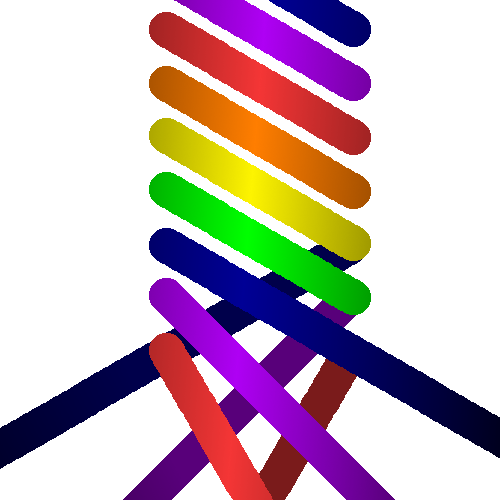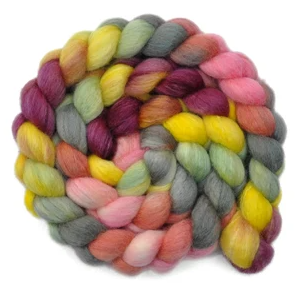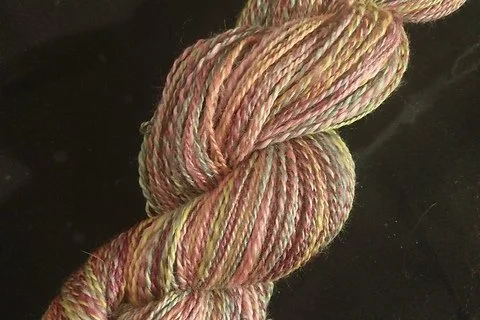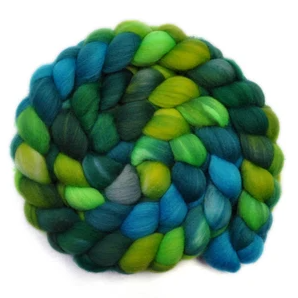Optical Blending
The Theory
Color is a fickle subject, especially in relation to fiber. That said, when we understand how things works, we become more adept at their use. One of the most important and often overlooked color tools we can put to work in our handspun repertoire is optical blending.
Optical blending is a trick of our eyes, or rather, our brains. The human brain is lazy. It does everything it can to reduce the amount of extra work it does. Our brains have more important work than interpreting color to perfection.
When we place small specs of different colors next to each other, the human eye can’t process and differentiate between those colors. Instead, it combines those dots of color to save our brain the processing power of identifying each dot of color.
Take the example in the graphics to the left. When large swatches of blue and yellow are near each other, we can clearly see that they are blue and yellow. When we shrink those swatches and place them close together or overlap them, our brain tries to interpret it as one color — green. The green isn’t actually present at all, even if we perceive it.
Optical blending is why we perceive a Pointillistic painting as an image and not just a series of paint dots.
The smaller the specs of color, the easier it is to trick our eyes and our brains.
Failing to Account for Optical Blending
Have you ever had a beautiful, bright painted top or roving that, after you spun it, looked muddy? This happens often when plying using a fractal technique.
Now, I’m going to preface this by saying that I love the yarn that I am using as an example. There is nothing inherently wrong with muddying colors. That said, if I had been trying to maintain the bright pops of burgundy and yellow in this top, I would have considered this yarn a failure.
Handpainted Silk/BFL “Tinkerbell” from Edgewood Garden Studio
In this example, I spun and plied a lovely Silk/BFL top from Edgewood Garden Studio as a fractal yarn. A fractal yarn is a yarn where the top is divided down the middle, length-wise. One half is spun directly, without any changes. The second half is further divided into smaller sections and spun end to end. Finally, the two yarns are plied together. This can create a subtle striping pattern with stripes which are less harsh than a self-striping yarn and all the colors of the top are carried throughout the yarn for a more balanced-looking yarn.
While this technique can be used to great effect, it can also fall victim to optical blending. On a color wheel, when you blend opposites, you get a grey or brown. Red + Green = Brown. Orange + Blue = Brown. Purple + Yellow = Brown.
Sometimes these colors can look nice next to each other, but in yarn, optical blending occurs when colors barber-pole around each other and cause your beautiful, bright colors to be muted (or muddied) toward brown.
Pink and green are roughly opposite on the color wheel. Purple and yellow are also roughly opposite on the color wheel. When those colors barber pole around each other (and even more so if you were to knit a swatch) optical blending happens. If you look at this yarn closely, you can see those individual colors that are present in the dyed top, but as you back away from it, those colors start to muddy together.
Making it Work
We can use optical blending to our advantage. Take this next yarn, for example.
A second top I picked up from Edgewood Garden Studio contained blues, greens, and little yellow. These colors are all adjacent on the color wheel. When optical blending occurs, instead of muting it toward brown, we perceive it as being nearest the center color, green.
Handpainted Merino/Nylon “Good Intentions 2” from Edgewood Garden Studio
The resulting yarn still appears bright and bold because we don’t have colors from opposite sides of the color wheel trying to cancel each other out.
Optical blending leads to a depth of color we don’t see with a solid dyed fiber preparation. It adds “visual interest.” And depending on the colors you’re working with, sometimes muddy colors may be desirable.
Before you start spinning, look at the colors in your top. Imagine how they might blend together. Then decide if that yarn wants to be a gradient, a fractal, or something else. A little color theory can help you make the conscious choice rather than letting your fiber dictate the yarn you make.
Resources on Optical Blending
“Carding a True Neutral“ by Meagan Condon, Spin Off - Fall 2023 p24
Cortical Brain Regions Associated with Color Processing: An FMRi Study
Winsor Newton - on Optical and Atomic Mixing
“I Ply with My Little Eye” Janel Laidman







